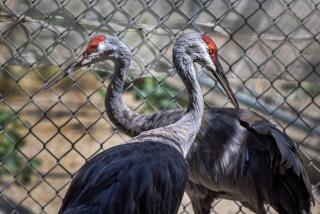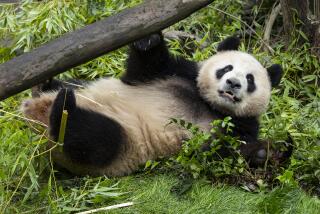Where Buffalo Roam : Bison, With Names Like King Lear and Lady Macbeth, Have Home in Golden Gate Park
- Share via
SAN FRANCISCO — No matter that the travel guides to this city are filled with pictures and maps to bridges, restaurants and cable cars. As Martin Dias sees it, it is bison that provide that special extra draw.
Yes, bison. They have roamed the far western end of Golden Gate Park, otherwise known for its fine museums and lush gardens, for more than a century.
“All the tour buses come by,” said Dias, motioning as a bus of sightseers slowed. Dias, or “Big Bison” to those who know him, tends the park’s bison for the San Francisco city zoo.
While plenty can be said for zoo favorites such as koalas and kangaroos, Dias claims that no other animal has the personality or intelligence of a bison. On a recent morning, Dias looked upon his herd and spoke proudly of the 16 horned and shaggy beasts.
As the bison ruminated their feed, Dias said he views his charges as characters out of Shakespeare. Hence, their names: King Lear, Macduff, Lady Macbeth.
Fittingly, these namesakes have shown a flair for drama. The male bison named Macduff set off a long-running feud when he challenged the pre-eminence of 1,800-pound King Lear, the herd’s dominant male.
Macduff, moved by the oldest and strongest of drives, was apparently seeking to mate with the female bison. “Macduff wasn’t the leader,” Dias said. “Only the leader mates. So there was a lot at stake.”
Finally, to stop the fighting, the San Francisco zoo sold Macduff and a dozen cohorts to a private owner in Sonoma County.
If it were not for a few benefactors, King Lear and the rest might have ended up stewed and slathered over sourdough at a San Francisco restaurant.
In 1984, Dick Blum, the investment banker husband of former Mayor Dianne Feinstein, happened to jog past the herd one day and noticed that many of the bison looked sickly. Blum, who recalled visiting the bison as a child, decided to help.
The bison, he learned, were suffering from an epidemic of tuberculosis. When Blum offered to open his checkbook to buy new bison, the zoo decided to move the sick herd to city-owned land near the San Francisco jail, where the survivors remain.
The question remained: Where to find new bison for sale? The city turned to Tommy Harris of Tommy’s Joynt, a restaurant whose fare includes buffalo stew. Harris called his meat supplier, Blum said, and in short order, 16 bison were shipped live, King Lear among them.
“It was a very good price,” Blum said. He continues to jog past the herd, but reports no noticeable reaction from the bison. “Their ability to recognize their benefactor is zero,” he said.
San Francisco has kept bison since 1890, when city leaders bought three head as an exhibit for a fair. In 1929, the city zoo was opened a few miles away, and other animals kept in Golden Gate Park were moved to their new quarters.
The first three bison were prolific--the herd has numbered as many as 100--and there was no room for them at the zoo. So they remain, seemingly out of place, in an 11-acre paddock in Golden Gate Park, under the care of San Francisco zoo veterinarians and Dias.
Dias, 54, might have chosen a life of suits and ties, but opted for the overalls and shovel of a zookeeper at age 31.
“I used to go to the zoo as my solace. I thought, ‘Wouldn’t it be wonderful to work here?’ So I did.”
To Dias, no other species has the personality of a bison. They are “one-man animals,” loyal to him.
A friend began calling him Big Bison years ago, after watching as Dias stared down a bison trying to escape through a gate. It was apparent, the friend noted, that Dias was “the Big Bison.” The name stuck, and today he is even listed that way in the phone directory.
More to Read
Sign up for Essential California
The most important California stories and recommendations in your inbox every morning.
You may occasionally receive promotional content from the Los Angeles Times.













